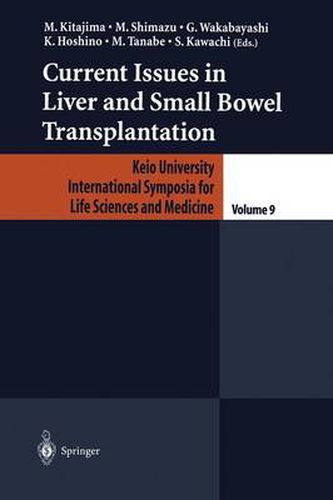Readings Newsletter
Become a Readings Member to make your shopping experience even easier.
Sign in or sign up for free!
You’re not far away from qualifying for FREE standard shipping within Australia
You’ve qualified for FREE standard shipping within Australia
The cart is loading…






This title is printed to order. This book may have been self-published. If so, we cannot guarantee the quality of the content. In the main most books will have gone through the editing process however some may not. We therefore suggest that you be aware of this before ordering this book. If in doubt check either the author or publisher’s details as we are unable to accept any returns unless they are faulty. Please contact us if you have any questions.
In Japan, cadaveric donor liver transplantation is not common even though cadaveric organ transplantation was legally established in 1998. In contrast, the number of living donor liver transplantations is increasing, with more than 1700 cases at 43 Japanese institutes by November 2001. Indications for and have become living donor liver transplantation are widening in Japan similar to those for cadaveric donor liver transplantation in the United States and Europe. At the same time, split liver transplantation from cadaveric donors shares some technical aspects with living donor liver transplantation. Remarkable progress has been reported recently, and thus it was an auspicious time to hold a symposium on Current issues in liver/small bowel transplantation in Japan. We were honored to hold a very fruitful symposium sponsored by the Keio University Medical Science Fund and to bring together top-rank transplant surgeons from Japan and other countries. It was a productive and rewarding time for all participants. We were able to share our experience through excellent presentations followed by active discussions and insightful com ments. At the symposium, we focused on current issues in liver transplanta tion such as widening indications for viral hepatitis and malignant tumors. We also discussed technical aspects and physiological problems in split/iiving donor liver transplant, novel strategies in immunosuppression, and the current status and future prospects in small bowel transplantation. This book contains the papers from all the distinguished guest speakers, focusing on the topics discussed at the symposium.
$9.00 standard shipping within Australia
FREE standard shipping within Australia for orders over $100.00
Express & International shipping calculated at checkout
This title is printed to order. This book may have been self-published. If so, we cannot guarantee the quality of the content. In the main most books will have gone through the editing process however some may not. We therefore suggest that you be aware of this before ordering this book. If in doubt check either the author or publisher’s details as we are unable to accept any returns unless they are faulty. Please contact us if you have any questions.
In Japan, cadaveric donor liver transplantation is not common even though cadaveric organ transplantation was legally established in 1998. In contrast, the number of living donor liver transplantations is increasing, with more than 1700 cases at 43 Japanese institutes by November 2001. Indications for and have become living donor liver transplantation are widening in Japan similar to those for cadaveric donor liver transplantation in the United States and Europe. At the same time, split liver transplantation from cadaveric donors shares some technical aspects with living donor liver transplantation. Remarkable progress has been reported recently, and thus it was an auspicious time to hold a symposium on Current issues in liver/small bowel transplantation in Japan. We were honored to hold a very fruitful symposium sponsored by the Keio University Medical Science Fund and to bring together top-rank transplant surgeons from Japan and other countries. It was a productive and rewarding time for all participants. We were able to share our experience through excellent presentations followed by active discussions and insightful com ments. At the symposium, we focused on current issues in liver transplanta tion such as widening indications for viral hepatitis and malignant tumors. We also discussed technical aspects and physiological problems in split/iiving donor liver transplant, novel strategies in immunosuppression, and the current status and future prospects in small bowel transplantation. This book contains the papers from all the distinguished guest speakers, focusing on the topics discussed at the symposium.